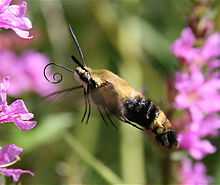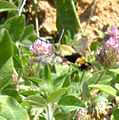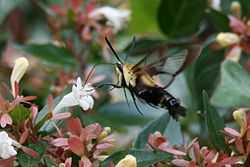Hemaris diffinis
| Snowberry clearwing | |
|---|---|
 | |
| Hemaris diffinis, Augusta, Michigan | |
| Conservation status | |
| Not evaluated (IUCN 3.1) | |
| Scientific classification | |
| Kingdom: | Animalia |
| Phylum: | Arthropoda |
| Class: | Insecta |
| Order: | Lepidoptera |
| Family: | Sphingidae |
| Genus: | Hemaris |
| Species: | H. diffinis |
| Binomial name | |
| Hemaris diffinis (Boisduval 1836)[1] | |
| Synonyms | |
| |
The snowberry clearwing (Hemaris diffinis) is a moth of the order Lepidoptera, family Sphingidae.
Adults
It is about 32–51 millimetres (1.25–2 in). The moth's abdomen has yellow and black segments much like those of the bumblebee, for whom it might be mistaken due to its color and flight pattern similarities. The moth's wings lack the large amount of scales found in most other lepidopterans, particularly in the centralized regions, making them appear clear. It loses the scales on its wings early after the pupa stage by its highly active flight tendencies. It flies during the daylight much like the other hummingbird moths, but it may also continue flight into the evening, particularly if it has found a good source of nectar.
Distribution
The moth is found from the Northwest Territories, British Columbia and in southern Ontario in Canada. In the United States this species has been located in southern California and Baja California Norte, east through most of the United States to Maine and Florida.
Food Plants
The larvae feed on plants including honeysuckle, viburnum, hawthorn, snowberry, cherry, mint, and plum.
Gallery
-
Hemaris diffinis
-
Hemaris diffinis variation
-
Snowberry clearwing (Hemaris diffinis), Lake Junaluska, North Carolina
-

Snowberry moth in Elizabethtown, Kentucky
-

Hemaris diffinis nectaring on Abelia
-

Caterpillar
References
- ↑ "CATE Creating a Taxonomic eScience - Sphingidae". Cate-sphingidae.org. Archived from the original on 2012-11-10. Retrieved 2011-10-19.
External links
| External identifiers for Hemaris diffinis | |
|---|---|
| Encyclopedia of Life | 508166 |
| Also found in: Wikispecies | |


